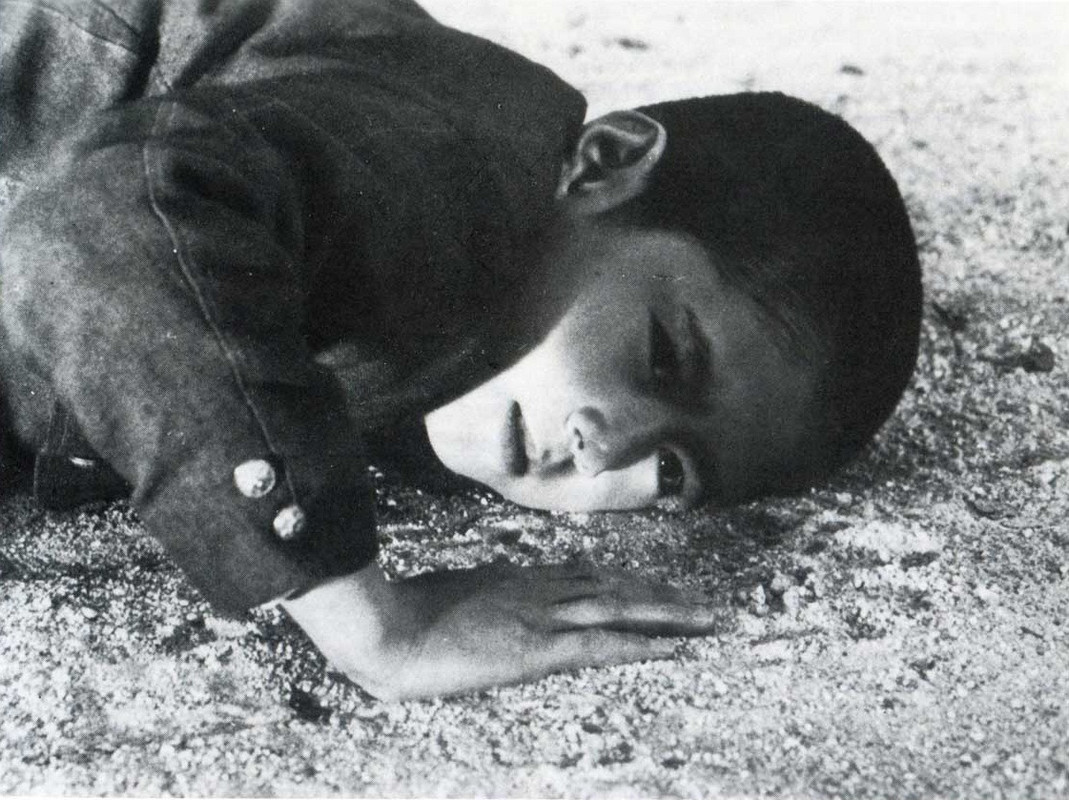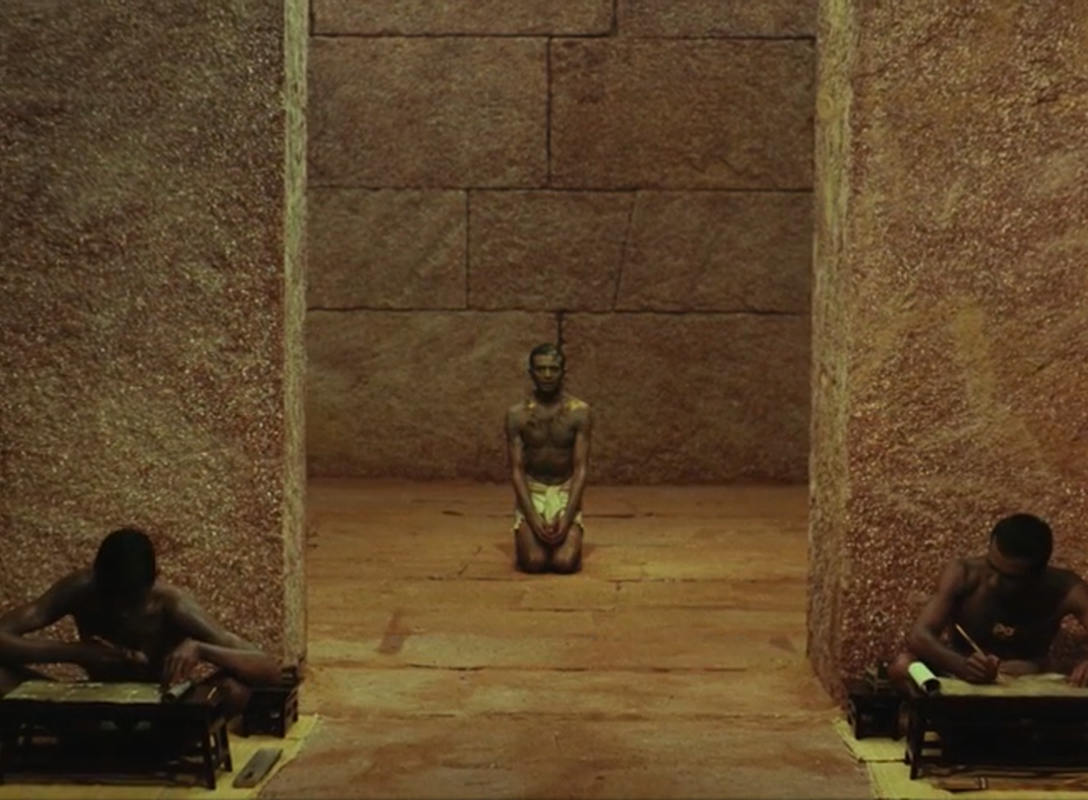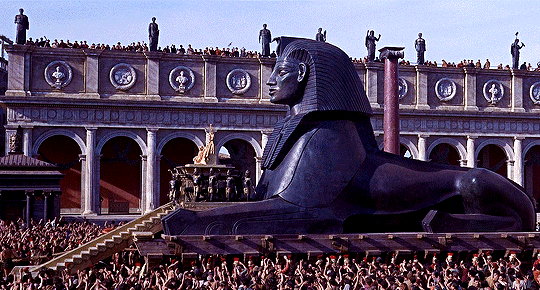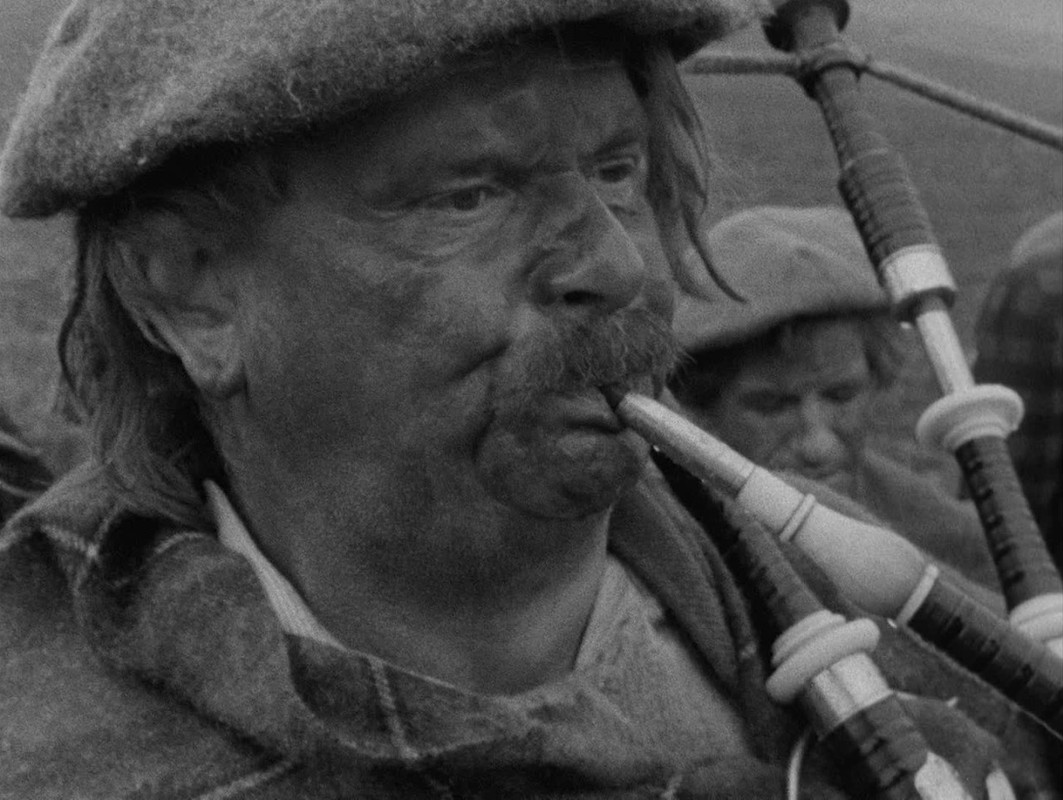“His body is golden like molten gold. This hand of his… will smooth away these wounds. Justin, he is as beautiful as the sun. This sun which caresses me… is his burning desire. He is Phoebus Apollo. The sun… is his… burning kiss.” Sebastiane (Paul Humfress + Derek Jarman, 1976)
Feb
18
Pluto Day

Sebastian (Leonardo Treviglio) sits on a rock in a barren landscape. Two men in the distance, and a sheep, all have their backs turned to him. DP: Peter Middleton.
Someone is snubbed or rejected on Pluto [Discovery] Day*.
– Sebastian
Sebastian, member of the Emperor's personal guard, is exiled after an incident. He finds himself on a rocky outpost, and the object of the other men's lust. One of them – a centurion rejected by the Christian boy – subjects Sebastian to torture and eventually lifts him up martyrdom.
* Pluto Demoted Day is on August 24
history
“In this film, by showing certain basic aspects of a city, a way of life is put on trial… the last gasps of a society so lost in its escapism that it sickens you and makes you sympathetic to a revolutionary solution.”À propos de Nice – point de vue documenté [À propos de Nice] (Boris Kaufman + Jean Vigo, 1930)
Jan
1
New Year's Day

Exuberant prostitutes, Jean Vigo (5th from the left), and some who appear to be men in drag, dance on a landing with confetti all around them. In the moving footage they can be seen high-kicking with increased vulgarity, the camera posed below them. DP: Boris Kaufman.
Confetti for New Year's Day.
– Jean Vigo in his manifesto Vers un cinéma social
儀式 [Gishiki / The Ceremony] (Nagisa Ōshima, 1971)
Jan
1

A boy in school uniform has his ear pressed against the ground. DP: Tōichirō Narushima.
Roj [The Swarm] (Miodrag 'Mića' Popović, 1966)
Dec
12
International Day of Neutrality

The judge and the woman. DP: Milorad Marković.
Trying to stay out of conflict on the International Day of Neutrality.
“Whoever dies for the country hasn't lived in vain. I, on the contrary, will live for the country because I'm not that stupid.”Touche pas à la femme blanche [Don't Touch the White Woman!] (Marco Ferreri, 1974)
Nov
23
potato chips

Two white Frenchmen – in a University of Columbia and a CIA sweatshirt respectively – comment on the “period piece” they're in. CIA man (Paolo Villaggio) stuffs his face with potato chips. DP: Étienne Becker.
– George A. Custer
“He's a peasant. Without looking into his situation, words are all he has.”شكاوى الفلاح الفصيح [El-Fallâh el-fasîh / The Eloquent Peasant] (Chadi Abdel Salam, 1970)
Dec
23
National Farmers Day – India

The peasant (Ahmed Marei) in a stone temple, flanked by scribes. DP: Mustafa Imam.
Farmers for Kisan Divas [National Farmers Day] (India)
4000 years ago, Egypt, Middle Kingdom. A peasant, leading his mules past a stream of water, is tricked. With his animals gone, he pleads to the Pharaoh to restore Maʽat, harmony.
Chadi Abdel Salam is not only this film's director, but also a trained architect, later set and costume designer. His eye wordlessly speaks the passing of time in the smallest of details. The withering of ferns, desert sand staining linen, the Sun merging with skin. At once, the universal presence of the gods becomes visible.
儀式 [Gishiki / The Ceremony] (Nagisa Ōshima, 1971)
Nov
11
World Origami Day

A man kneeled in front of a Shintō altar. Ceremonial origami, known as origata or girei origami can be seen hanging from the altar. This is 幣帛 [heihaku], an offering made of cloth or paper. DP: Tōichirō Narushima.
“There are never enough hours in the days of a queen, and her nights have too many.” Cleopatra (Joseph L. Mankiewicz + Rouben Mamoulian, 1963)
Aug
26
National Spark The World Day

Cleopatra's – Elizabeth Taylor, anachronistically dressed as the goddess Nekhbet – grande entrée in Rome. She sits on top of a black, basalt-like sphinx, pulled by numerous slaves and greeted by a cast of thousands. There are 20 000 Italian extras; there's no CGI. DPs: Leon Shamroy & Jack Hildyard.
Like Rome, Cleopatra wasn't built in a day. Joseph L. Mankiewicz's epic studio breaker took six years to make and, despite it being the highest-grossing film of 1963, didn't break even until 1973. Was it a #flop? A classic flop but a flop nevertheless?
– Cleopatra
The star – the Queen – Elizabeth Taylor demanded an unprecedented one million dollar fee, 10,3 million in 2023 US dollars. Liz's movie dressing table hold trinkets especially designed by luxury brand Bulgari, blink and you'll miss them. The Pharaoh's lavish costumes, all 65 of them (created by Irene Sharaff who would dress Taylor again as #Cleopatra's counterpart Martha in Who's Afraid of Virginia Woolf? (1966)), cost almost 195K dollar (ca. 2 million today), and of course those 20 000 extras, shipped from God-knows-where to Hollywood on the Tiber to shoot one scene, had to look like their 2000 year old counterparts, and be fed, and housed.
Is it all bad? Cleopatra is one of those movies that so many – and that includes obsessive cinephiles – will get around to watch. Eventually. All four hours of it. I'm still holding out, but ooh, the spectacle!
“And wherever he went, he took with him his music, his poetry, his language and his children… thus within a century of Culloden, the English and the Scottish lowlanders had made secure forever their religion, their commerce, their culture, their ruling dynasty.”Culloden [The Battle of Culloden] (Peter Watkins, 1964)
Jul
27
Bagpipe Appreciation Day

John Hunt Leigh in Culloden, pìobaireachd “ceòl mór” (litt. piping “great music”). DP: Dick Bush.
Great Highland #bagpipes, or a' phìob mhòr as they're called in Scottish Gaelic, are traditionally played on the battlefield. Peter Watkins' Culloden moves the senseless bloodshed from 1960s Vietnam to the Scottish Highlands of 1746.
– narrator
The most clearly it's seen in the men's eyes. That stare we recognise all too well from the many images that reached the west in the 60s, ever before and after.
“Shoulder to shoulder. The land is ours. Tomorrow is ours.”Броненосец Потёмкин [Bronenosets Potyomkin / Battleship Potemkin] (Sergei Eisenstein, 1925)
Jun
8
Bounty Day

A closeup of a sailor. DPs: Eduard Tisse & Vladimir Popov.
– sailor